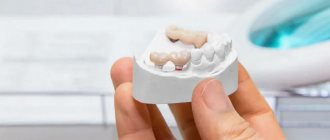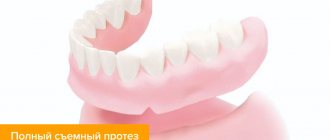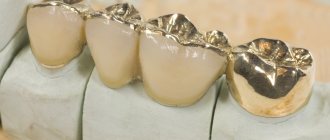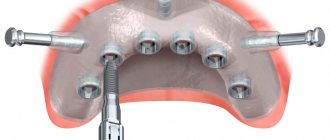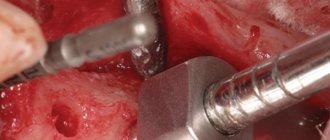Strong teeth have always been of great importance for human health. Any problems in this area created a lot of inconvenience, including for ancient people. Even they, as historical excavations show, tried to restore the integrity of the dentition with improvised means, using them as dentures. But the history of implantation began when the first attempts to “implant” artificial teeth into the jawbone appeared.
The very first cases of using dental implants
Several centuries BC, the Phoenicians tried to use similar implants, which were fixed with gold wire. Attempts to “grow in” new “teeth” have been used for many centuries, but were not successful, since the body rejected foreign objects.
However, about 1,500 years ago, the Aesculapians seem to have succeeded in introducing implants into the jawbone. An x-ray of the lower jaw, which belonged to a person of that time, showed the presence of implanted pieces of shells in the bone, overgrown with bone tissue. It is clear that in ancient times attempts to “implant” new teeth into the jaw were sporadic and not always successful. At that time there was no concept of the need for sterility. People also knew nothing about the properties of many materials. Therefore, those first attempts were rather just “harbingers” of a new method of tooth restoration.
History of implantable technology. Dentures
Since prehistoric times, man has sought to replace teeth lost due to injury or infection. The first materials used for this purpose were the fruit of human intelligence and the foresight of nature. In the very early days of dental implants, they were made from small stones or carved from wood. It was only many centuries later, in the era of advanced industry, that new methods and technologies were developed to replace missing human teeth.
Most of the efforts of doctors then were aimed at the rehabilitation of partially or completely edentulous patients. And only the advent of intraosseous dental implants as we know them today made it possible to solve this problem that has lasted for many centuries.
Antiquity
People have used dental implants in one form or another to replace missing teeth since the beginning of human history. Around 2500 B.C. The ancient Egyptians tried to strengthen decaying teeth using gold ligature wire. Additionally, there are several interesting references to dental caries found in ancient Egyptian manuscripts, which first identified it as a dental problem.
Around 500 BC Etruscan tribes used human and animal teeth as prosthetics and filled holes in their teeth with gold plates. They also created dentures from ox bones. Around this same period, the Phoenicians used gold wire to strengthen teeth that had become susceptible to periodontitis. Around 300 AD these progressive peoples used carved ivory implants that were held together with gold wire to create a fixed bridge.
Golden “splint” that fixed the teeth of the Etruscans
The first evidence of dental implants dates back to 600 AD. The Mayans then made significant progress in using shell pieces as dentures to replace lower teeth. In X-rays of Mayan mandibles taken in the 1970s, scientists discovered solid bone growth around the implants. This was very similar to the way bone grows around the post of modern dentures.
Mayan implants
Middle Ages and Renaissance
In the period from the 16th to the 19th centuries in Europe, the problem of dentures was solved in a non-trivial way - the necessary teeth were simply removed from the jaws of the deceased and replaced those missing from the patient. In the 18th century, Dr. John Hunter collaborated with people who secretly stole corpses from graves. With so much material to analyze, Hunter observed and described in detail the anatomy of the mouth and jaw.
Transplanting teeth from one person to another is also his idea. Hunter's experiment involved implanting an underdeveloped tooth into bone. As a result of the experiment, the tooth was firmly embedded in the bone and blood vessels grew directly in the tooth pulp.
19th century
In the 19th century in Europe, damaged teeth were restored using various substances - silver capsules, fluted porcelain and iridium tubes. In 1806, Dr. Fonzi invented the mineral tooth, a discovery that would have great implications for the future development of implantology. His main achievement was the idea of manufacturing single artificial teeth that could be implanted directly into the “socket” using platinum hooks, fulfilling aesthetic and functional requirements, as well as being chemically resistant. Fonzie's work influenced the work of his other contemporaries. In particular, the first attempt was made to create an intraosseous metal implant. Such a prosthesis was developed in 1809 and implanted into the socket of a patient’s extracted tooth by the Italian Maggiolo.
XX century
1900-1930
Dr. E. J. Greenfield in 1913 placed a hollow lattice cylinder made of an alloy of iridium and platinum, soldered with 24-karat gold as an artificial root, which was placed in a circular incision into the patient's jaw bone. In the 1930s, brothers Alvin and Moses Strock experimented with screws made from a chromium-cobalt alloy. They watched doctors successfully place similar implants in the femur and began performing similar surgeries themselves to restore individual teeth. Such pins provided fastening and support for replacing a lost tooth. The Strock brothers were recognized for their work in successfully selecting a biocompatible metal for use in tooth replacement.
Greenfield implant
The Strock brothers are also believed to have been the first to successfully place an intraosseous implant. Dr. Alvin Strock has worked with more than just implant materials. He also pioneered the use of antibiotics to treat periodontal infections such as Vincent's angina.
In 1938, Dr. PB Adams patented a cylindrical endosseous implant with a gingival cap and abutment that holds the gingiva in position.
Adams Patent Outline
In the 40s, the “father of modern implantology” Formigini and Zepponi developed an endosseous implant in the form of a stainless steel spiral, allowing fusion of bone and metal. Dr. Perron Andres from Spain modified the spiral design of the Formigini denture to include a solid shaft.
Formigini spiral
1940 – 1950
In the 1940s, some physicians began to focus on developing subperiosteal (subperiosteal) implants.
The first denture based on the bone tissue of the alveolar process was proposed by the Swedish doctor Gustav Dahl. The idea of subperiosteal implantation is based on the strength of attachment of collagen fibers of the periosteum to bone tissue, which can ensure the stability of the implant itself and the denture resting on it. In Sweden, the invention was met with hostility by the dental community, but in the USA, on the contrary, this idea found wide support and was recognized by many famous specialists. This idea was developed by other doctors. So Gershkoff and Goldberg developed a cobalt-chromium-molybdenum implant with an improved Dahl design, to which an external inclined ridge was added. The subperiosteal design of the prosthesis was further developed by Lew, Bausch and Berman in 1950.
Throughout history, the main problem facing doctors was that flesh and bones rejected foreign bodies. For implantation to be successful, osseointegration is necessary - an anatomical and functional direct connection between the changing living bone and the surface of the implant, which bears the main load. This means that during the chewing process, the implant directly affects the bone. In the absence of a tooth, the bone tissue atrophies due to insufficient load, and the installation of a denture solves this problem and stimulates its development, preventing destruction.
In 1952, Swedish orthopedic surgeon Per-Ingvar Branemark accidentally discovered the special properties of titanium, which greatly increases the success of osseointegration. He was interested in studying bone healing and regeneration, and decided to introduce a small optical camera developed in Cambridge, which was surgically inserted into the tibia of a rabbit. The optical camera body was made of titanium.
During his research, he found that the bone and titanium cylinder had fused successfully, so he continued his experiments on animals and humans. In 1965, orthopedist Brånemark placed the first titanium dental implant in a volunteer. This was a turning point in the history of dentistry: over the next decade, the implantation process was greatly improved.
1960-1980
An important milestone was the creation of self-tapping implants by Leonard Linkow in 1964. Two years later, he also introduced the intra-alveolar blade implant made of chromium, nickel and vanadium. At that time, blade-type implants were not considered clinically successful.
Dental implants in the 60s and 70s
In the 1970s, dentures took on a familiar appearance. Of course, over the following decades, the original dental implant underwent a number of improvements in structure and design, but it was always based on the same principle.
In 1978, Dr. Brånemark introduced the two-stage titanium root-form implant. He developed and tested a system using pure titanium screws, which were first placed in his patients' jaws in 1965. This was the first documented case of the most successfully implanted implants that have existed so far. Branemark's first patient had a severe deformation of the jaw and chin, as well as uneven teeth, some of which were missing entirely due to a birth defect. Branemark placed four implants in the lower jaw, which took root over the next six months and subsequently successfully served their owner for another 40 years.
Two other innovators in implantology are Dr. Shroder and Dr. Straumann. They experimented with metals used in orthopedic surgery to help make dental implants.
Since the mid-1980s, many physicians have used root-form endosseous implants. The main factors determining the advantage of endosseous implant systems were the design, rough surface to promote healing, ease of insertion into the bone, cost of their manufacture and their long-term success.
Modernity
Dental implants have proven to be a truly suitable replacement for missing teeth since the 1970s. However, it took several decades to make dental implants reliable. Researchers delved deeper into dental implantology, focusing on the introduction of ceramic-like elements, such as zirconia, in the manufacture of dentures. The researchers chose this particular material because of its close position in the periodic table to titanium. In addition, zirconium dioxide has similar bio-compatibility properties to titanium. For the last 15 years, crowns and dentures have been made from this material.
Modern dental implants consist of a rough titanium alloy screw. Surface roughness is essential for successful osseointegration. This titanium screw is attached to the spot in the jaw where the tooth used to be, and a period of healing follows. After the screw has grown into the jaw, a crown is attached on top of it. With proper care and oral hygiene, this method has a high long-term success rate.
The new generation of implants merges with the jaw, which ensures their natural and comfortable wearing. Successful denture placement requires healthy gums, a strong jawbone, and good oral hygiene.
Subperiosteal implants
Modern subperiosteal implants use a saddle-shaped metal frame that is placed into the jawbone directly under the gum tissue. The frame is attached to the jawbone as the gums heal. The posts attached to it protrude from the gums, and artificial teeth are already attached to them. Intraosseous implants are surgically implanted directly into the jawbone. Once the tissue and gums surrounding the implant have healed, an abutment and crown are attached to it.
Implantology continues to evolve under the influence of technological opportunities. In 2015, researchers developed a process for creating implants and braces using a 3D printer. These implants are based on a material that kills almost 99% of all bacteria in the oral cavity. Quaternary ammonium salts are used in its production. Because they are positively charged, they destroy negatively charged bacterial membranes, causing them to die.
Beginning of the scientific approach to dental implantation
At the end of the 19th century, for the first time, Russian doctor N. N. Znamensky gave a report on dental implantation at one of the congresses of doctors. The scientist drew the attention of the medical community to the fact that:
- the implant must be installed in the bone, and not in the socket of the extracted tooth;
- bone tissue must be properly processed and prepared for the introduction of an artificial root;
- the implant must be made of a material that is biocompatible with body tissues.
The results of the scientist’s research attracted attention, but the doctor did not have time to pass on his notes to his heirs. Therefore, there was a break in the history of implantation that lasted until the mid-20th century.
Spreading the discovery around the world
When George Zarb, one of the most influential scientists in the development of artificial tooth root replacements (University of Toronto, Canada), learned about Brånemark's research, he immediately went to Gothenburg, where he spent six months convincing the professor to share the results of his research with the world. Zarb and his group were the first to conduct research outside Sweden in parallel with Brånemark. In order to accelerate the dissemination of the concept of osseointegration, a conference on osseointegration was held in 1982 in Toronto (Canada), on the basis of one of the dental clinics, with the support of the Universities of Toronto and Gothenburg. Zarb personally wrote an invitation to many famous researchers and scientists, urging them to study a new and original technique for restoring teeth. Most dentists attended the conference only because of Professor Zarb's invitation and later noted that they did not expect such a superiority of the new technology over all previous developments. Despite 15 years of clinical research, not only in Sweden, Brånemark was concerned whether the top dental society would accept his presentation; however, at the end of the conference, the scientist’s research was so highly appreciated that over the following years, many participants in this conference even became his employees. Since then, several world-renowned institutions have joined the team of developers and researchers of osseointegration in countries such as the United States, Canada, Australia, Belgium, Sweden, Spain, Italy, Brazil, Chile, Japan and Korea.
Based on materials from Chapter 1 of the book “At the Beginnings - Brånemark and the Development of Osseointegration” - McClarence, Elaine - Quintessence Books, Berlin, Germany, 2003.
Implantology of new times
Dentistry owes the appearance of the first dental implants, similar to those currently used, to the Swedish scientist Ingvar Brånemark. The professor was researching the phenomenon of osseointegration, which he discovered in 1952. While conducting his experiments, Dr. Brånemark accidentally discovered the amazing properties of titanium - its bioinertness and ability to firmly fuse with bone tissue. Based on these and other data obtained by the Swedish scientist, the first titanium implants were developed, which were intended for fixing dentures.
In addition to Brånemark, other specialists also experimented with the properties of titanium. For example, orthopedic dentist L. Linkow installed his first titanium implant back in 1952 and successfully did so until 2002, so some experts consider him the founder of modern implantology.
Implantology of the 19th century
The rapid development of science and technology in the 19th century brought medicine of that time to a new level. In 1806, the first “mineral” tooth was invented, which became the basis for the development of modern implantology. The discovery was made by Dr. Fonzi. He developed a technique by which “mineral” teeth could be inserted in place of a missing tooth and secured with platinum hooks. This work was received with great enthusiasm by contemporaries, and for the first time in 1809, Dr. Magillo (Italy) implanted a tooth into a patient using a metal intraosseous implant.
Development of dental implantation today
A modern classic implant is made of titanium and has the shape of a cone or cylinder, with a mandatory thread. But implantology continues to develop. One of its promising directions is the use of zirconium dioxide for the production of artificial roots. This material is also durable, bioinert and close to titanium in some other properties. However, zirconium implants give dentists more options in terms of aesthetics of prosthetics.
The history of implantation today is not yet completed. Scientists in many countries continue to search for new production technologies and methods for installing dental implants. The goal is to improve the quality, comfort and effectiveness of treatment and extend the life of root substitutes.
Implantology of the 20th century
At the beginning of the century, Dr. Greenfield became interested in implantology. He performed an operation on his patient, during which a semblance of a tooth made of an alloy of iridium and platinum with an artificial gold root was placed into the jaw. In the 1930s, the Stroke brothers experimented with screws made from a chromium-cobalt alloy. They were the first to produce pins as fastenings for artificial teeth. The Stroke brothers have received worldwide recognition for their work. They were the first to discover biocompatible materials for tooth replacement.
In the 40s of the twentieth century, Dr. Formingini and Dr. Zepponi, who are rightly called the fathers of implantology, developed a spiral stainless steel implant that fused perfectly with the bone.
Throughout the century, there has been an intense search for further ways to improve materials and techniques for dental implantation.
In the 50s, titanium's ability to osseointegrate was discovered. This paved the way for experiments in the implantation of titanium pins, which led to very successful results. In 1965, Dr. Brånemark placed the first titanium implant in a volunteer. This was a turning point in the development of implantology.
Rice. 3. Dental implants in the 60s and 70s.
Already in the 70s, implants acquired a modern look, but experiments with materials and shapes continued. Dr. Branemark successfully used titanium implants in his practice, which took root well and served patients for decades. Also innovators in implantology were Dr. Schroeder and Dr. Straumann. They conducted various experiments with new alloys in orthopedic surgery to use these methods in dental implantation.
Abutment installation stage
At the stage of permanent prosthetics, the crown is placed not on the implant itself, but on its abutment, which is screwed into a titanium rod. The abutment is placed on the implant approximately two weeks after installation of the former; the abutment is selected individually for each clinical case. For example, if implantation was carried out in the area of the front teeth and the patient has thin gums, it is recommended to install zirconium abutments, since the use of conventional titanium products can have a bad effect on the aesthetics of the final result.
Installation of the abutment is the final stage of implantation, but the overall treatment does not end with this procedure, because a crown must be placed on the abutment.
Orthopedic stage
Implant crowns are placed approximately two weeks after the abutment is installed. Dentures are made according to individual impressions of the patient’s teeth, and crowns made of any materials can be placed on the implants. For prosthetics of front teeth, ceramic products are most often used; for the restoration of chewing units, prostheses made of zirconium, which have increased strength and can flawlessly withstand intense and constant loads, are used.
The price of the permanent prosthetics stage will depend on the type of prosthesis (not only crowns can be placed on implants), the material of its manufacture and technology.
Fig.5 Dental implantation.
Stage of installation of the gum former
A gum former is a special device that helps create a beautiful soft tissue contour in the area where the implant is installed. The former is screwed onto the implant after the osseointegration process of the artificial rod is completed.
To place the former on the implant, the doctor will need to make an incision in the gum in the area of the installed plug. Having gained access to the plug, the implantologist will unscrew it and install the former in its place. The procedure for installing the former is quick, literally in half an hour, but since it involves an incision of soft tissue, the patient is given local anesthesia before performing all the necessary manipulations.
The gum contour will be formed in about two weeks, after which you can proceed to the next stages of treatment - installing an abutment and a crown on the implant.


